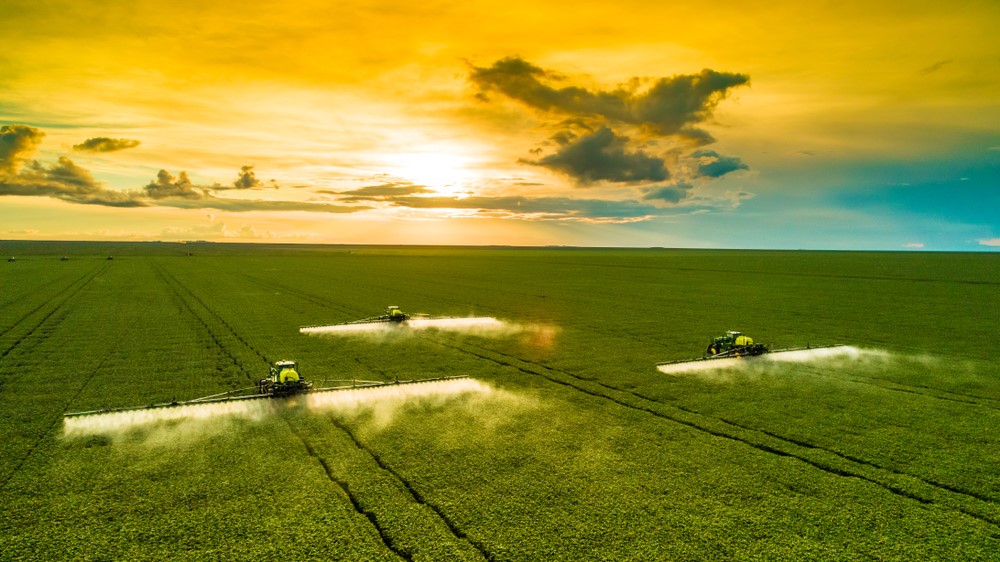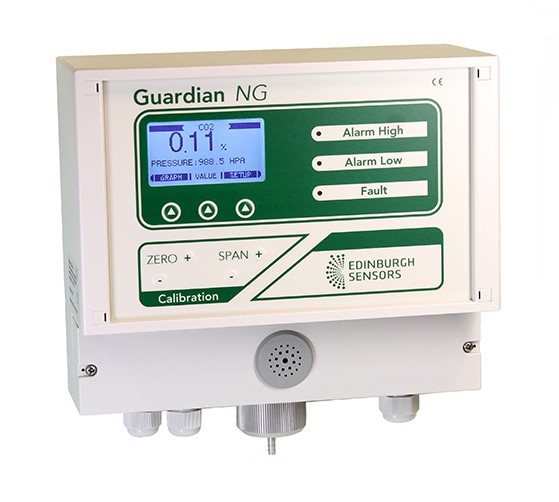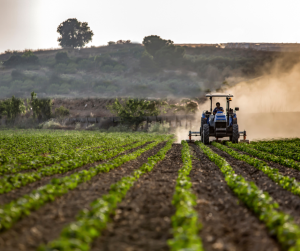Agriculture in the UK is responsible for 9% of total greenhouse gas emissions, with that number rising to 30% of worldwide total emissions.1 There are a variety of sources for such gases in agriculture, including methane production from livestock, carbon dioxide release on soil disturbance, and emissions from farm machinery.2-4
The question is how to reduce such emissions. Under the 2008 Climate Change Act, the agriculture industry has pledged to reduce greenhouse gas emissions by 11% by 2022. Each and every farmer must contribute towards these national targets and changes to improve sustainability and reduce the environmental impact of farming practices must be made.

Image Credit: lourencolf/Shutterstock.com
There is a great deal of active research into improving farming practices which spans all aspects of the food production process. Optimisation of the composition of animal diets or the use of additives for feedstocks to reduce methane produced by ruminating animals are all options to reduce emissions from livestock farming.5,6 For crops, maintaining good quality soil conditions plays an important role in minimising emissions as building organic carbon content in soil helps increase its sequestration capacity, though the balance between sequestration capacity and emissions can be a complex one.7
Monitoring Changes and High-Quality Data
It is impossible for farmers to make improvements to minimise their overall farmland emissions if they have no data on current emission levels and sources. High-quality, accurate data collection for greenhouse gas emissions necessitates the use of gas sensors at several sites around the farm e.g. in milking pens for monitoring livestock, near storage areas for grain, in greenhouses, etc. Ideally, such sensors should be capable of automated, online data collection and logging to avoid the need for labour-intensive, regular measurements and so that datasets are not distorted by daily or seasonal fluctuations in emissions levels.
Particularly for monitoring livestock emissions, it is important that measurements can be made as part of the animals ‘daily routine’ without the need for specialist testing chambers or areas that may stress the animal and alter their emission levels. 8,9 Minimisation of the labour associated with making measurements and use of robust online sensors that can be installed and are relatively maintenance free are all important aspects of helping encourage the uptake of emissions monitoring by individual agriculture sites and gathering meaningful datasets that can be used to better identify problem areas and even compare different sites at a national level.
NDIR Gas Sensors
One of the most sensitive approaches for the detection of gases such as carbon dioxide and methane is the use of infra-red spectroscopy. Both gases absorb infra-red radiation very strongly and have unique absorption patterns or spectral fingerprints, that can be used for their subsequent identification. Infra-red detection can be used for both qualitative and quantitative identification and therefore can be used to detect very low concentrations of such gases or small changes in their concentration.
Edinburgh Sensors have over 30 years of expertise in the development of non-dispersive infra-red sensor technologies and offer a range of production options suitable for tracking greenhouse gas emissions on agricultural sites. Their products have been field-tested and are very successful at tracking methane production from cattle in a working environment.10
What makes Edinburgh Sensor’s products ideal for monitoring gas production in agriculture is that their sensors are designed to be robust with minimal need for maintenance and simple to install. The GasCard11 and Guardian NG12 has a field-serviceable infra-red source that can be quickly installed with just a connection to a reference gas and a data logging device.
Accurate and Robust
The GasCard NG and Guardian NG offer a carbon dioxide and methane detection range of 0 – 3000 ppm and 0 – 100% volume. The GasCard NG also comes with additional sensor options that can cover up to 0 – 5000 ppm if desired. Both maintain an excellent ±2% accuracy across the full measurement range so can be relied upon to continually track changing gas levels in online operation.
As there may be many different locations with many different environmental conditions or conditions that change through different extremes, both sensors come with onboard pressure, temperature, and humidity compensation so the accuracy of measurements is unaffected by environmental fluctuations. These corrections span 0 – 95% humidity conditions, 0 – 45ºC and 800mbar to 1150mbar (for the GasCard NG).

The Guardian NG comes with its own graphical display for historical data as well as built-in programmable alarms. The sensor enclosure has been IP54 approved to help improve its lifetime and avoid contamination even in dirty and dusty environments. However, for fully online measurements both sensors come with the option for connection to external data logging, either via true RS232 communications protocol or, for the GasCard NG, also the option of TCP/IP communications.
The sensors can detect gases from sources over 30 m away, so are suitable for use in large indoor areas and their rapid T90 response times of less than 30s from the inlet mean that even fast fluctuations in gas concentrations can easily be monitored. With either the option of Edinburgh Sensor’s own logging software or customized solutions if necessary, these sensors are an excellent choice for straightforward monitoring of greenhouse gas emissions from farming and a crucial tool in finding effective measures to help minimize said emissions.
References
- An Assessment of Greenhouse Gas Emissions from the UK Food System, Food Climate Research Network (2009), http://assets.wwf.org.uk/downloads/how_low_report_1.pdf, accessed 10th October 2020
- Meat Production, Hannah Ritchie and Max Rosser, (2019), https://ourworldindata.org/meat-production, accessed 12th October 2020
- Oertel, C., Matschullat, J., Zurba, K., Zimmermann, F., & Erasmi, S. (2016). Greenhouse gas emissions from soils—A review. Chemie Der Erde, 76(3), 327–352. https://doi.org/10.1016/j.chemer.2016.04.002
- Stuart, D., Schewe, R. L., & McDermott, M. (2014). Reducing nitrogen fertilizer application as a climate change mitigation strategy: Understanding farmer decision-making and potential barriers to change in the US. Land Use Policy, 36, 210–218. https://doi.org/10.1016/j.landusepol.2013.08.011
- Hulshof, R. B. A., Berndt, A., Gerrits, W. J. J., Zijderveld, S. M. Van, Newbold, J. R., & Perdok, H. B. (2012). Dietary nitrate supplementation reduces methane emission in beef cattle fed. Journal of Animal Science, 90(7), 2317–2323. https://doi.org/10.2527/jas2011-4209
- Hristov, A. N., Oh, J., Giallongo, F., Frederick, T. W., Harper, M. T., Weeks, H. L., … Kindermann, M. (2015). An inhibitor persistently decreased enteric methane emission from dairy cows with no negative effect on milk production. PNAS, 112(34), 10663–10668. https://doi.org/10.1073/pnas.1504124112
- Oertel, C., Matschullat, J., Zurba, K., Zimmermann, F., & Erasmi, S. (2016). Greenhouse gas emissions from soils—A review. Chemie Der Erde, 76(3), 327–352. https://doi.org/10.1016/j.chemer.2016.04.002
- Gold – Difford, G. F., Olijhoek, D. W., Hellwing, A. L. F., Lund, P., Bjerring, M. A., de Haas, Y., … Løvendahl, P. (2018). Ranking cows’ methane emissions under commercial conditions with sniffers versus respiration chambers. Acta Agriculturae Scandinavica A: Animal Sciences, 68(1), 25–32. https://doi.org/10.1080/09064702.2019.1572784
- Grainger, C., Clarke, T., McGinn, S. M., Auldist, M. J., Beauchemin, K. A, Hannah, M. C., Waghorn, G. C., et al. (2007). Methane emissions from dairy cows measured using the sulfur hexafluoride (SF6) tracer and chamber techniques. Journal of Dairy Science 90(6), 2755–2766.
- Rey, J., Atxaerandio, R., Ruiz, R., Ugarte, E., González-Recio, O., Garcia-Rodriguez, A., & Goiri, I. (2019). Comparison between non-invasive methane measurement techniques in cattle. Animals, 9(8), 1–9. https://doi.org/10.3390/ani9080563

